#bernardinelli
Explore tagged Tumblr posts
Text
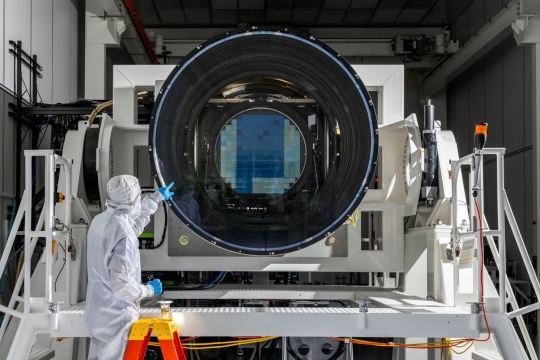
The camera on the Vera C. Rubin Observatory, seen during final stages of completion at SLAC National Accelerator Laboratory in Palo Alto, contains 189 individual sensors and will take photos at 3.2 gigapixels—the largest digital camera ever built.
Is There A 9th Planet Out There? We May Soon Find Out.
Starting in 2025 The Vera C. Rubin Observatory Will Increase the Number of Known Objects Circling the Sun by Roughly Tenfold, Spotting New Comets, Exotic Asteroids From Other Stars, and Perhaps Even the Elusive Planet Nine.
— By Robin George Andrews | Photographs By Christie Hemm Klok | January 09, 2024
Our solar system is home to wondrous worlds, mysterious moons, astounding asteroids, and curious comets. But despite myriad telescope surveys of the night sky, most of our celestial neighborhood remains unseen and unknown.
That’s about to change. Thanks to a revolutionary new telescope, huge swaths of the undiscovered solar system will finally come into view. The Vera C. Rubin Observatory (VRO), currently under construction atop the Cerro Pachón ridge in Chile, 8,700 feet up, is not merely going to advance the field of astronomy—it’s going to revolutionize it. A marvel of engineering, software, and scientific ingenuity, this machine has one overarching goal: to document the entire night sky.
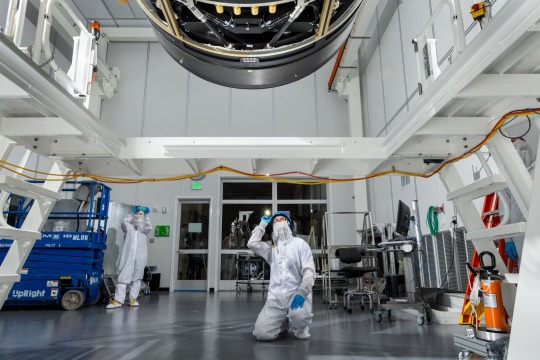
Lead Engineer, Travis Lange, inspects the front of the VRO camera lens with a high powered flashlight, looking for dust. The heart of the new observatory, this advanced camera will image the entire Southern Hemisphere sky many times over.
This includes distant objects, from convulsing stars to cosmic explosions, but also the countless objects in the solar system that have eluded skygazers. “It’s going to be a quite complete catalogue of everything in the solar system out to and beyond Neptune,” says Mario Jurić, an astronomer at the University of Washington working with VRO.
The asteroid tally will almost immediately skyrocket. The first asteroid was discovered in 1801. Two centuries later, a million were known. VRO will double that in three to six months.
The observatory may even find the hypothetical Planet Nine, a large world that some astronomers believe is hiding at the solar system’s peripheries. “Probably within the first year we’re going to see if there’s something there or not,” says Pedro Bernardinelli, an astronomer at the University of Washington.
And VRO is set to spot dozens of interstellar objects—visiting entities that have been ejected from other star systems. With these exotic shards of space rock, “we can literally start to figure out what other planetary systems look like,” says Juríc.
Over the course of its ten-year survey, set to commence in 2025, VRO will give astronomers a new encyclopedia of the solar system. “And then we get to understand what that’s all telling us,” says Juríc—about the very origins and evolution of our galactic cradle.
“I think it’s going to rewrite the history books,” says Meg Schwamb, an astronomer at Queen’s University Belfast working with VRO.
Chile’s Almighty Eye
The Vera C. Rubin Observatory, jointly funded by the National Science Foundation and the Department of Energy, is named after the famed astronomer who revealed the existence of dark matter—an as-yet-undetected substance binding stars and galaxies together. Designed to address a multitude of cosmic queries, the cutting-edge observatory is a beast of a scientific instrument.
“Everything is big about Rubin,” says Sandrine Thomas, the deputy director for VRO construction. “The telescope is superfast. The camera is huge and very precise. The detector is also extremely big. The number of pixels is gigantic.”
Most observatories have either a wide field of view, meaning they can see more of the sky at once, or a huge mirror, which allows more light to be gathered, revealing fainter and more distant objects. But thanks to its paradigm-shifting engineering, VRO has both. It will peruse the entire night sky viewable from the Southern Hemisphere countless times during its decade-long survey, seeing almost everything, almost everywhere.
“This is a once-in-a-generation leap,” says Bernardinelli.
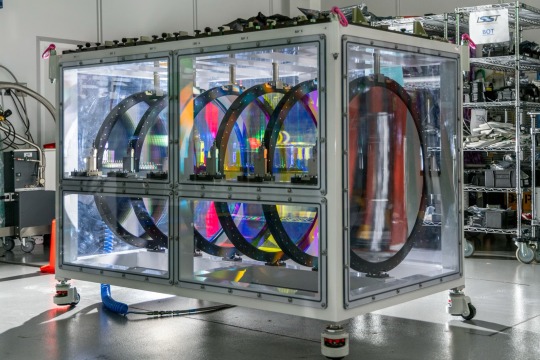
A large airtight box holds filters for the VRO camera. Nitrogen continuously pumped into the chamber is dryer than natural air and prevents the glass from warping.
Beyond The Veil
Many of the worlds VRO will spot will be in the asteroid belt. “This is the mortar left over from planet formation,” says Schwamb.
The observatory will undoubtedly find many modestly sized asteroids orbiting close to Earth, the sort that have so far eluded asteroid-hunting surveys. That means VRO could find future Earth-impactors before they find us, so that we can attempt to avoid a catastrophic asteroid impact.
Other asteroids may be found drifting inside Earth’s orbit, perhaps as part of a hypothesized reservoir of space rocks swimming about close to Venus. And while VRO will populate the inner solar system, it is also set to reveal the architecture of the outer solar system for the first time.
As well as increasing the tally of moons belonging to Jupiter and Saturn (the famously ringed planet currently has 146 confirmed moons), VRO will be able to spy comets starting to effervesce further out than ever before. Apart from a few highly volatile elephantine comets, most of these far-ranging ice balls are not spotted until they approach the sunlit confines of the inner solar system, where they heat up and shed a trail of icy debris.
VRO may permit astronomers to fulfil a long-time dream: find a comet long before it plunges sunward for the first time in its existence. This would represent a pristine, unaltered record from the dawn of the solar system. With enough advance notice, astronomers could even chase it down before it starts cooking. “We’ll be able to send a spacecraft to get up close and personal,” says Schwamb.
Comets come from two places. The Oort Cloud, a hypothesized shell of icy worlds at an unfathomable distance from the sun, has never been directly seen—and VRO won’t change that. But the Kuiper Belt, a torus-shaped ring of gelid objects, including the dwarf planet Pluto, will have its portrait taken by VRO in considerable detail.
Currently, only a few thousand Kuiper Belt objects, or KBOs, have been identified. VRO is expected to find at least that many. The observations will reveal the true structure and contents of the icy belt, and it could also solve a great mystery about the solar system: “How many planets do we have?” says Schwamb.
Over the last decade, some astronomers have suggested that the peculiar orbits of objects at the solar system’s fringes means a Neptune-size planet is lurking somewhere out there, far beyond Pluto. Existing telescopes are highly unlikely to spot such a distant world—but VRO should find Planet Nine, if it exists.
“Imagine if, two years from now, we could say that there’s a new planet in the solar system,” says Bernardinelli. “That’s kind of exciting.”
Visitors From Beyond The Solar System
In 2017 astronomers detected something amazing: the very first interstellar object, 1I/ʻOumuamua, a thin asteroid or comet that had escaped the gravitational grip of another star. It moved into and then out of the solar system at remarkable speeds, giving scientists only a few days to study it. Then, in 2019 a second planetary tourist was found, the comet 2I/Borisov.
With just two known, scientists have very little information about the nature of such interstellar objects. They remind Schwamb of the corners of old maps that no seafarers had yet chronicled: “There be dragons,” she says.
Fortunately, VRO is projected to find a handful of new interstellar objects every year. These envoys from different star systems contain matter that was forged in stellar and planetary environments different from our solar system.
“They’re a sample of the planet formation process at stars all across the galaxy,” says Michele Bannister, an astronomer at the University in Canterbury in New Zealand.
The VRO’s sophisticated eye allows it to see objects in a range of colors, which means scientists can not only spot interstellar objects at considerable distances, but also get an idea of what they are made of. And while the VRO plays the role of the reconnaissance scout, scientists can use other telescopes with a smaller fields of view but better zoom-in capabilities to get closer looks at these alien time capsules.
“If we found one of these things as it was still approaching, and we had a year to observe it, that would be fantastic,” says Juríc.
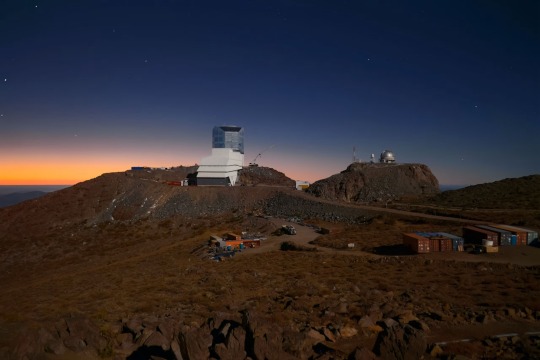
The Vera C. Rubin Observatory sits beneath a twilight sky at its site in Chile. Rubin is being built to conduct the Legacy Survey of Space and Time (LSST). This survey will observe the entire visible southern sky every few nights over the course of a decade, capturing about 1,000 images every night. Rubinobs/NSF/Aura
Everlasting Change
Like all ground-based observatories, VRO will be hampered by the proliferation of low-flying, highly reflective satellites, particularly those belonging to SpaceX’s internet-providing Starlink megaconstellation. The roughly 4,500 Starlinks currently in orbit are already adding bright, white streaks to many astronomical images. SpaceX plans to launch tens of thousands more satellites in the future, which could mean 30 percent of all VRO images would be graffitied.
At present, there is no clear solution to this problem. “We will have to deal with it because we don’t have a choice,” says Bernardinelli. But while megaconstellation light pollution will mar some of VRO’s views, it won’t stop the observatory from being the discovery engine that astronomers have long dreamed about.
“The detail that will be revealed, this beautiful complexity that’s gonna show up—that will fine tune our ability to go from broad-brush histories of the solar system” to something more measured and precise, says Bannister. Currently, as scientists study the outer solar system’s structure, it’s like “seeing faces in clouds.” The VRO will mean that “we have Michelangelo’s David.”
#Telescope 🔭 | Planets 🪐 🪐 | Planetary Moons 🌓 🌒 🌑 | Asteriods ☄️ | Solar System | Space#9th Planet#Vera C. Rubin Observatory
0 notes
Text
Digibee raises $60M to help companies integrate their software apps
Digibee, a low-code integration platform geared toward enterprise organizations, today announced that it raised $60 million in a Series B funding round led by Goldman Sachs with participation from Leadwind, Southern Europe, Vivo Ventures, Brazilian telco Vivo, Kinea and G2D. The round brings Weston, Florida-based Digibee’s total raised to $90 million, which CEO Rodrigo Bernardinelli said is being…

View On WordPress
0 notes
Text
Digibee raises $60M to help companies integrate their software apps
Digibee, a low-code integration platform geared toward enterprise organizations, today announced that it raised $60 million in a Series B funding round led by Goldman Sachs with participation from Leadwind, Southern Europe, Vivo Ventures, Brazilian telco Vivo, Kinea and G2D. The round brings Weston, Florida-based Digibee’s total raised to $90 million, which CEO Rodrigo Bernardinelli said is being…

View On WordPress
0 notes
Text
Digibee raises $60M to help companies integrate their software apps
Digibee, a low-code integration platform geared toward enterprise organizations, today announced that it raised $60 million in a Series B funding round led by Goldman Sachs with participation from Leadwind, Southern Europe, Vivo Ventures, Brazilian telco Vivo, Kinea and G2D. The round brings Weston, Florida-based Digibee’s total raised to $90 million, which CEO Rodrigo Bernardinelli said is being…

View On WordPress
0 notes
Text
Digibee raises $60M to help companies integrate their software apps
Digibee, a low-code integration platform geared toward enterprise organizations, today announced that it raised $60 million in a Series B funding round led by Goldman Sachs with participation from Leadwind, Southern Europe, Vivo Ventures, Brazilian telco Vivo, Kinea and G2D. The round brings Weston, Florida-based Digibee’s total raised to $90 million, which CEO Rodrigo Bernardinelli said is being…

View On WordPress
0 notes
Text
Digibee raises $60M to help companies integrate their software apps
Digibee, a low-code integration platform geared toward enterprise organizations, today announced that it raised $60 million in a Series B funding round led by Goldman Sachs with participation from Leadwind, Southern Europe, Vivo Ventures, Brazilian telco Vivo, Kinea and G2D. The round brings Weston, Florida-based Digibee’s total raised to $90 million, which CEO Rodrigo Bernardinelli said is being…

View On WordPress
0 notes
Text
Digibee raises $60M to help companies integrate their software apps
Digibee, a low-code integration platform geared toward enterprise organizations, today announced that it raised $60 million in a Series B funding round led by Goldman Sachs with participation from Leadwind, Southern Europe, Vivo Ventures, Brazilian telco Vivo, Kinea and G2D. The round brings Weston, Florida-based Digibee’s total raised to $90 million, which CEO Rodrigo Bernardinelli said is being…

View On WordPress
0 notes
Photo

Bernardinelli akár 24 órában felvásárol.
Orosházi Friss Hírek, 1939. június 21.
0 notes
Link
1 note
·
View note
Text
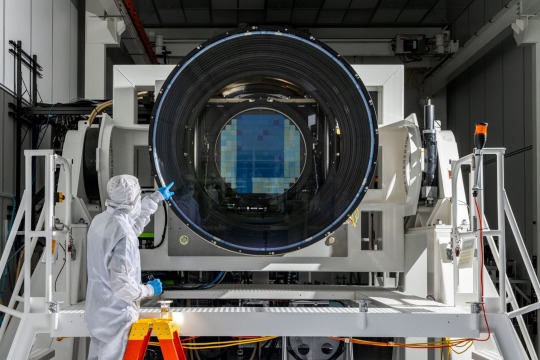
The camera on the Vera C. Rubin Observatory, seen during final stages of completion at SLAC National Accelerator Laboratory in Palo Alto, contains 189 individual sensors and will take photos at 3.2 gigapixels—the largest digital camera ever built.
Is There A 9th Planet Out There? We May Soon Find Out.
Starting in 2025 the Vera C. Rubin Observatory will increase the number of known objects circling the sun by roughly tenfold, spotting new comets, exotic asteroids from other stars, and perhaps even the elusive Planet Nine.
— By Robin George Andrews | Photographs By Christie Hemm Klok | January 9, 2024
Our solar system is home to wondrous worlds, mysterious moons, astounding asteroids, and curious comets. But despite myriad telescope surveys of the night sky, most of our celestial neighborhood remains unseen and unknown.
That’s about to change. Thanks to a revolutionary new telescope, huge swaths of the undiscovered solar system will finally come into view. The Vera C. Rubin Observatory (VRO), currently under construction atop the Cerro Pachón ridge in Chile 🇨🇱, 8,700 feet up, is not merely going to advance the field of astronomy—it’s going to revolutionize it. A marvel of engineering, software, and scientific ingenuity, this machine has one overarching goal: to document the entire night sky.
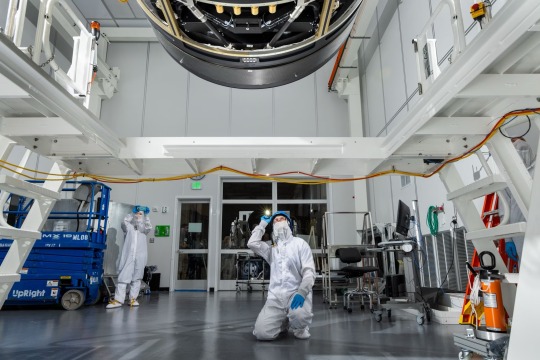
Lead Engineer, Travis Lange, inspects the front of the VRO camera lens with a high powered flashlight, looking for dust. The heart of the new observatory, this advanced camera will image the entire Southern Hemisphere sky many times over.
This includes distant objects, from convulsing stars to cosmic explosions, but also the countless objects in the solar system that have eluded skygazers. “It’s going to be a quite complete catalogue of everything in the solar system out to and beyond Neptune,” says Mario Jurić, an astronomer at the University of Washington working with VRO.
The asteroid tally will almost immediately skyrocket. The first asteroid was discovered in 1801. Two centuries later, a million were known. VRO will double that in three to six months.
The observatory may even find the hypothetical Planet Nine, a large world that some astronomers believe is hiding at the solar system’s peripheries. “Probably within the first year we’re going to see if there’s something there or not,” says Pedro Bernardinelli, an astronomer at the University of Washington.
And VRO is set to spot dozens of interstellar objects—visiting entities that have been ejected from other star systems. With these exotic shards of space rock, “we can literally start to figure out what other planetary systems look like,” says Juríc.
Over the course of its ten-year survey, set to commence in 2025, VRO will give astronomers a new encyclopedia of the solar system. “And then we get to understand what that’s all telling us,” says Juríc—about the very origins and evolution of our galactic cradle.
“I think it’s going to rewrite the history books,” says Meg Schwamb, an astronomer at Queen’s University Belfast working with VRO.
Chile’s 🇨🇱 Almighty Eye
The Vera C. Rubin Observatory, jointly funded by the National Science Foundation and the Department of Energy, is named after the famed astronomer who revealed the existence of dark matter—an as-yet-undetected substance binding stars and galaxies together. Designed to address a multitude of cosmic queries, the cutting-edge observatory is a beast of a scientific instrument.
“Everything is big about Rubin,” says Sandrine Thomas, the deputy director for VRO construction. “The telescope is superfast. The camera is huge and very precise. The detector is also extremely big. The number of pixels is gigantic.”
Most observatories have either a wide field of view, meaning they can see more of the sky at once, or a huge mirror, which allows more light to be gathered, revealing fainter and more distant objects. But thanks to its paradigm-shifting engineering, VRO has both. It will peruse the entire night sky viewable from the Southern Hemisphere countless times during its decade-long survey, seeing almost everything, almost everywhere.
“This is a once-in-a-generation leap,” says Bernardinelli.
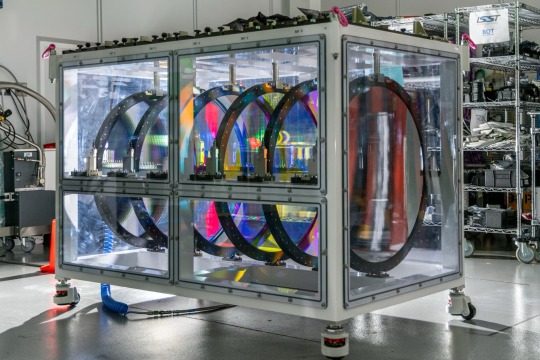
A large airtight box holds filters for the VRO camera. Nitrogen continuously pumped into the chamber is dryer than natural air and prevents the glass from warping.
Beyond the Veil
Many of the worlds VRO will spot will be in the asteroid belt. “This is the mortar left over from planet formation,” says Schwamb.
The observatory will undoubtedly find many modestly sized asteroids orbiting close to Earth, the sort that have so far eluded asteroid-hunting surveys. That means VRO could find future Earth-impactors before they find us, so that we can attempt to avoid a catastrophic asteroid impact.
Other asteroids may be found drifting inside Earth’s orbit, perhaps as part of a hypothesized reservoir of space rocks swimming about close to Venus. And while VRO will populate the inner solar system, it is also set to reveal the architecture of the outer solar system for the first time.
As well as increasing the tally of moons belonging to Jupiter and Saturn (the famously ringed planet currently has 146 confirmed moons), VRO will be able to spy comets starting to effervesce further out than ever before. Apart from a few highly volatile elephantine comets, most of these far-ranging ice balls are not spotted until they approach the sunlit confines of the inner solar system, where they heat up and shed a trail of icy debris.
VRO may permit astronomers to fulfil a long-time dream: find a comet long before it plunges sunward for the first time in its existence. This would represent a pristine, unaltered record from the dawn of the solar system. With enough advance notice, astronomers could even chase it down before it starts cooking. “We’ll be able to send a spacecraft to get up close and personal,” says Schwamb.
Comets come from two places. The Oort Cloud, a hypothesized shell of icy worlds at an unfathomable distance from the sun, has never been directly seen—and VRO won’t change that. But the Kuiper Belt, a torus-shaped ring of gelid objects, including the dwarf planet Pluto, will have its portrait taken by VRO in considerable detail.
Currently, only a few thousand Kuiper Belt objects, or KBOs, have been identified. VRO is expected to find at least that many. The observations will reveal the true structure and contents of the icy belt, and it could also solve a great mystery about the solar system: “How many planets do we have?” says Schwamb.
Over the last decade, some astronomers have suggested that the peculiar orbits of objects at the solar system’s fringes means a Neptune-size planet is lurking somewhere out there, far beyond Pluto. Existing telescopes are highly unlikely to spot such a distant world—but VRO should find Planet Nine, if it exists.
“Imagine if, two years from now, we could say that there’s a new planet in the solar system,” says Bernardinelli. “That’s kind of exciting.”
Visitors From Beyond the Solar System
In 2017 astronomers detected something amazing: the very first interstellar object, 1I/ʻOumuamua, a thin asteroid or comet that had escaped the gravitational grip of another star. It moved into and then out of the solar system at remarkable speeds, giving scientists only a few days to study it. Then, in 2019 a second planetary tourist was found, the comet 2I/Borisov.
With just two known, scientists have very little information about the nature of such interstellar objects. They remind Schwamb of the corners of old maps that no seafarers had yet chronicled: “There be dragons,” she says.
Fortunately, VRO is projected to find a handful of new interstellar objects every year. These envoys from different star systems contain matter that was forged in stellar and planetary environments different from our solar system.
“They’re a sample of the planet formation process at stars all across the galaxy,” says Michele Bannister, an astronomer at the University in Canterbury in New Zealand 🇳🇿.
The VRO’s sophisticated eye allows it to see objects in a range of colors, which means scientists can not only spot interstellar objects at considerable distances, but also get an idea of what they are made of. And while the VRO plays the role of the reconnaissance scout, scientists can use other telescopes with a smaller fields of view but better zoom-in capabilities to get closer looks at these alien time capsules.
“If we found one of these things as it was still approaching, and we had a year to observe it, that would be fantastic,” says Juríc.
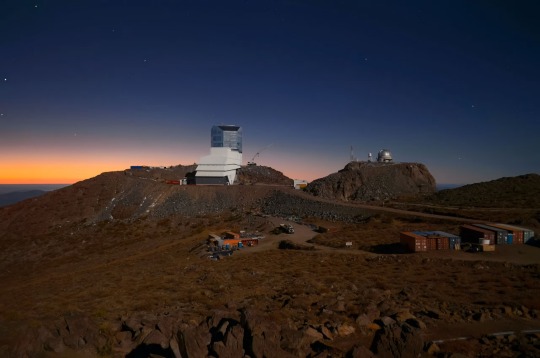
The Vera C. Rubin Observatory sits beneath a twilight sky at its site in Chile. Rubin is being built to conduct the Legacy Survey of Space and Time (LSST). This survey will observe the entire visible southern sky every few nights over the course of a decade, capturing about 1,000 images every night. Rubinobs/NSF/AURA
Everlasting Change
Like all ground-based observatories, VRO will be hampered by the proliferation of low-flying, highly reflective satellites, particularly those belonging to SpaceX’s internet-providing Starlink megaconstellation. The roughly 4,500 Starlinks currently in orbit are already adding bright, white streaks to many astronomical images. SpaceX plans to launch tens of thousands more satellites in the future, which could mean 30 percent of all VRO images would be graffitied.
At present, there is no clear solution to this problem. “We will have to deal with it because we don’t have a choice,” says Bernardinelli. But while megaconstellation light pollution will mar some of VRO’s views, it won’t stop the observatory from being the discovery engine that astronomers have long dreamed about.
“The detail that will be revealed, this beautiful complexity that’s gonna show up—that will fine tune our ability to go from broad-brush histories of the solar system” to something more measured and precise, says Bannister. Currently, as scientists study the outer solar system’s structure, it’s like “seeing faces in clouds.” The VRO will mean that “we have Michelangelo’s David.”
#Planet 🌎#Vera C. Rubin Observatory#Robin George Andrews#Number of Planets?#Chile 🇨🇱#New Zealand 🇳🇿#National Science Foundation#Department of Energy
0 notes
Photo

2 notes
·
View notes
Link

L'osservatorio Las Cumbres ha catturato una nuova immagine della cometa gigante C/2014 UN271 (Bernardinelli-Bernstein) che ne mostra l'attività nonostante la distanza notevole dato che è ben oltre l'orbita di Saturno. Le informazioni raccolte anche cercando immagini di archivio come quelle che hanno permesso di identificarla in un'immagine del 2014 sono utili per capirne meglio le caratteristiche. In particolare, le stime iniziali suggerivano che il suo diametro fosse di almeno 100 chilometri, il triplo della più grande cometa conosciuta, ma si tratta di stime basate sull'assenza di una chioma. C/2014 UN271 rimarrà lontana dal Sole, arrivando vicina all'orbita di Saturno all'inizio del 2031 perciò potrà essere ammirata solo con i telescopi ma potrebbe essere comunque molto interessante perché probabilmente arriva dall nube di Oort.
1 note
·
View note
Text
Dev Kuyruklu Yıldız Geliyor!
Dev Kuyruklu Yıldız Geliyor!
Dev Kuyruklu Yıldız Geliyor! Everest Dağı’nın iki katı büyüklüğündeki Dev Kuyruklu Yıldız K2, Dünya’ya doğru yola çıkıyor! Dev Kuyruklu Yıldız K2, Dünya’ya en yakın geçişini yapmasına sadece saatler kaldı. Keşfedilen en uzak aktif kuyruklu yıldız Bernardinelli – Bernstein tarafından bu yılın başında kırılmıştı. Ancak K2 son beş yıldır istikrarlı bir şekilde bize doğru geliyor. İç güneş…

View On WordPress
#Bernardinelli – Bernstein#Bernardinelli – Bernstein ve Hale-Bopp#Dev Kuyruklu Yıldız#Dev Kuyruklu Yıldız Geliyor#Dev Kuyruklu Yıldız K2#Hale-Bopp#K2#K2 Dev Kuyruklu Yıldız#K2 Kuyruklu Yıldızı#kuyruklu yıldız
0 notes
Link
Descoberto o maior cometa já observado, Bernardinelli-Bernstein é um monstro que tem 128 km de extensão e pesa mais de 500 trilhões de toneladas.
0 notes
Text
Nasa confirma que núcleo de megacometa é o “maior já visto”
Nasa confirma que núcleo de megacometa é o “maior já visto”
Com 500 trilhões de toneladas, gigante se aproxima do Sol em 2031Com cerca de 129 quilômetros de circunferência, o núcleo do cometa C/2014 UN271, também conhecido como Bernardinelli-Bernstein, é o maior já observado pela agência aeroespacial norte-americana Nasa, informou o órgão na terça-feira (12). Imagens do telescópio Hubble confirmaram as dimensões do núcleo gelado do cometa, que é 50 vezes…

View On WordPress
0 notes